A Class of Spectral Element Methods and Its A Priori/A Posteriori Error Estimates for 2nd-Order Elliptic Eigenvalue Problems
Abstract
This paper discusses spectral and spectral element methods with Legendre-Gauss-Lobatto nodal basis for general 2nd-order elliptic eigenvalue problems. The special work of this paper is as follows. (1) We prove a priori and a posteriori error estimates for spectral and spectral element methods. (2) We compare between spectral methods, spectral element methods, finite element methods and their derived p-version, h-version, and hp-version methods from accuracy, degree of freedom, and stability and verify that spectral methods and spectral element methods are highly efficient computational methods.
1. Introduction
As we know, finite element methods are local numerical methods for partial differential equations and particularly well suitable for problems in complex geometries, whereas spectral methods can provide a superior accuracy, at the expense of domain flexibility. Spectral element methods combine the advantages of the above methods (see [1]). So far, spectral and spectral element methods are widely applied to boundary value problems (see [1, 2]), as well as applied to symmetric eigenvalue problems (see [3]). However, it is still a new subject to apply them to nonsymmetric elliptic eigenvalue problems.
A posteriorii error estimates and highly efficient computational methods for finite elements of eigenvalue problems are the subjects focused on by the academia these years; see [3–16], and among them, for nonsymmetric 2nd-order elliptic eigenvalue problems, [5, 15] provide a posteriori error estimates and adaptive algorithms, [9] the function value recovery techniques and [8, 10] two-level discretization schemes.
- (1)
We prove a priori and a posteriori error estimates of spectral and spectral element methods with Legendre-Gauss-Lobatto nodal basis, respectively, for the general 2nd-order elliptic eigenvalue problems.
- (2)
We compare between spectral methods, spectral element methods with Legendre-Gauss-Lobatto nodal basis, finite element methods, and their derived p-version, h-version, and hp-version methods from accuracy, degree of freedom, and stability and verify that spectral methods and spectral element methods are highly efficient computational methods for nonsymmetric 2nd-order elliptic eigenvalue problems.
This paper is organized as follows. Section 2 introduces basic knowledge of second elliptic eigenvalue problems. Sections 3 and 4 are devoted to a priori and a posteriori error estimates of spectral and spectral element methods, respectively. In Section 5, some numerical experiments are performed by the methods mentioned above.
2. Preliminaries
We denote the complex Sobolev spaces with norm ∥·∥m by Hm(Ω), . Let (·, ·) and ∥·∥0,Ω be a inner product and a norm in the complex space L2(Ω), respectively.
In this paper, C denotes a generic positive constant independent of the polynomial degrees and mesh scales, which may not be the same at different occurrences.
We assume that Kh = {κ} is a regular rectangle (resp. cuboid) or simplex partition of the domain Ω and satisfies . We associate with the partition a polynomial degree vector N = {Nκ}, where Nκ is the polynomial degree in κ. Let hκ be the diameter of the element κ, and let .
We assume that f ∈ L2(Ω) and derive from Lax-Milgram theorem that the variational formations (5), (6), (10), and (11) have a unique solution, respectively.
We quote from [2] (see (5.8.27) therein) the interpolation estimates for spectral and spectral element methods with LGL Nodal-basis as follows.
Note that (18) is also suited to spectral methods with modal basis (see [1, 2]).
3. Spectral and Spectral-Element Approximations and Error Estimates for Eigenvalue Problems
3.1. Spectral and Spectral-Element Approximations for Eigenvalue Problems
Let λ be an eigenvalue of (23). There exists a smallest integer μ, called the ascent of λ, such that ker ((λ−1 − T) μ) = ker ((λ−1 − T) μ+1). q = dim ker ((λ−1 − T) μ) is called the algebraic multiplicity of λ. The functions in ker ((λ−1 − T) μ) are called generalized eigenfunctions of T corresponding to λ. Likewise the ascent, algebraic multiplicity and generalized eigenfunctions of λN,h, λ* and can be defined.
Let λ be an eigenvalue of (23) with the algebraic multiplicity q and the ascent μ. Assume ; then there are eigenvalues λj,N,h (j = 1,2, …, q) of (26) which converge to λ. Let M(λ) be the space spanned by all generalized eigenfunctions corresponding to λ of T, and let MN,h(λ) be the space spanned by all generalized eigenfunctions corresponding to all eigenvalues of TN,h that converge to λ.
In view of adjoint problems (31) and (32), the definitions of M*(λ*) and are analogous to M(λ) and MN,h(λ). Let , and let .
Note that when b = 0, both (24) and (26) are symmetric. Thus, the ascent μ = 1 of λ, and the ascent l = 1 of λN,h.
3.2. A Priori Error Estimates
We will analyze a prior error estimates for spectral element methods which are suitable for spectral methods with mesh fineness h not considered.
Assume that R and U are two closed subspace in .
We give the following four lemmas from Theorem 8.1–8.4 in [17], which are applications to spectral element methods.
Lemma 1. Assume . For small enough h and big enough N, there holds
Lemma 2. Assume ; then
Lemma 3. Assume that ; then there holds
Lemma 4. Assume . Let λN,h be an eigenvalue of TN,h and lim N→∞,h→0λN,h = λ. uN,h satisfies and , where k ≤ μ is a positive integer. Then, for every integer l ∈ [k, μ], there holds
We assume that in this section, for the sake of simplicity, Nκ = N, ∀κ ∈ Kh.
Theorem 5. If and , then there holds the following error estimates:
Proof. We derive from the error estimate (20) that
Supposing that , ρ(T) is a regular set of T, and Γ ⊂ ρ(T) is a closed Jordan curve enclosing λ−1.
We give the following lemma by referring to [18, 19] (see proposition 5.3 in [18] and theorem 1.3.2 in [19]).
Lemma 6. If , then there holds that EN,h → E(p), R(TN,h, z) is uniformly bounded with N and h, and
Theorem 7. Under the assumptions of Theorem 5, further assume that the ascent of λ is μ = 1. Let (λN,h, uN,h) be an eigenpair of (26) with ; then there exists an eigenpair (λ, u) of (24), such that
Let (λ, u) be an eigenpair of (24). If λN,h is an eigenvalue of (26) convergence to λ, then there exists , such that (51)–(53) hold.
Proof. We deduce (53) immediately from (41). We derive from (22) and (7) that
If (λ, u) is an eigenpair of (24), let uN,h = EN,hu; by the same argument we can prove (51) and (52).
4. A Posteriori Error Estimates
We refer to the hp-clément interpolation estimates given by [20, 21] (see theorems 2.2 and 2.3, respectively), which generalize the well-known clément type interpolation operators studied in [22] and [23] to the hp context.
Lemma 8. Assume that the partition Kh is γ-shape regular and the polynomial distribution N is comparable. Then there exists a positive constant C = C(γ) and the clément operator , such that
Define interval and weight function . Denote the reference square and triangle element by and , respectively. Define weight function .
The following three lemmas are given by [20]. Lemmas 9–10 provide the polynomial inverse estimates in standard interval and element, while Lemma 11 provides a result for the extension from an edge to the element.
Lemma 9. Let −1 < α < β, σ ∈ [0,1]. Then there exists C = C(α, β), such that for all N ∈ ℕ and all univariate polynomials πN of degree N,
Lemma 10. Let −1 < α < β, σ ∈ [0,1]. Then there exist C1 = C(α, β), C2 = Cσ > 0, such that for all N ∈ ℕ and all polynomials πN of degree bi-N,
Lemma 11. Let , ; then there exists Cα > 0 such that for all N ∈ ℕ, ε ∈ (0,1], and all univariate polynomials π of degree N, there exists an extension and holds
It is easy to know that the three lemmas above hold for complex-valued polynomials.
Let Dκ, bκ, and cκ be the interpolations of D, b, and c in κ with the polynomial degree Nκ (resp. degree Nκ in every direction), respectively, or the L2(κ)-projection on the space of polynomials with degree Nκ. For convenient argument, here and hereafter we assume that (λ, u) and are the eigenpairs of the eigenvalue problem (24) and its adjoint problem (31), respectively. (λN,h, uN,h) and are the solutions of the corresponding spectral element approximations (26) and (32), respectively.
Theorem 12. Let α ∈ [0,1]. Then there exists a constant C > 0 independent of h, N, and κ, such that
Proof. We denote w : = u − uN,h − I(u − uN,h), where I is hp-clément operator given by Lemma 8. We derive from -elliptic of a(·, ·) that
Using scaled transformation and setting α = 0, β = α in (61) and (62), we get and ; then this proof concludes.
For the adjoint eigenvalue problem, we still have the following.
Theorem 13. Let α ∈ [0,1]. Then there exists a constant C > 0 independent of h, N, and κ, such that
Lemma 14. Let α ∈ [0,1], ε > 0. Then there exists a constant C(ε) > 0 independent of h, N, and κ, such that
Proof. We denote with α ∈ (0,1] and extend vκ to Ω by vκ = 0 on Ω∖κ; then
Since , we obtain
Lemma 15. Let α ∈ [0,1], ε > 0. Then there exists a constant C(ε) > 0 independent of h, N, and κ, such that
Proof. We will use weight functions on edge and a suitable extension operator. For a given element κ with edge e, we choose the element κ1 so that ∂κ1∩∂κ = e. Denote ; we construct a function with as follows.
Let (Ce is defined by (71)). Using Lemma 11, we extend to , where the polynomial π corresponds to CeDκ[∂uN,h/∂n]. Define we|κ and as the affine transformation of in ; Thus, we is a piecewise H1-function. From (64), we know we vanishes on ∂κe; Therefore, . It is trivial to extend we to Ω, such that we = 0 in Ω∖κe. We find
Setting in the above inequality yields the assertion for α > 1/2. For the case of α ∈ [0,1/2], we set β = 1/2 + ε, use (62) in Lemma 10 to get , and find the desired result.
Combining Lemmas 14 and 15, we obtain the following theorem.
Theorem 16. Let α ∈ [0,1], ε > 0. Then there exists a constant C > 0 independent of h, N, and κ, such that
Similarly, we have Theorem 17.
Theorem 17. Let α ∈ [0,1], ε > 0. Then there exists a constant C > 0 independent of h, N, and κ, such that
In order to estimate bounds of |λ − λN,h|, we also need Lemma 18 (see [8, 10]).
Lemma 18. Let (λ, u) be an eigenpair of (24), and let be the associated eigenpair of the adjoint problem (31). Then for all , (w, w*) ≠ 0,
Theorem 19. Under the assumptions of Theorem 7, we assume that D, b, and c are smooth enough, and let α ∈ [0,1]. Then there exists an eigenpair (λ, u) of (24), such that
Proof. We know from the assumption . By the interpolation error estimates (14) and (15), we have
If the eigenvalue problem (23) is symmetric (i.e., b = 0), then
Remark 20. Babuška and Osborn [17] have discussed hp finite element approximation with simplex partition for eigenvalue problems. Obviously, the Interpolation estimates (14) and (15) hold for hp finite element with simplex partition (see [24]). Therefore, our theoretical results of spectral methods and spectral methods for eigenvalue problems, which have been discussed in Sections 3 and 4, hold for hp finite element with simplex partition.
5. Numerical Experiments
In this section, we simply denote spectral methods, spectral element methods, and finite element methods with SM, SEM, and FEM, respectively. And spectral methods with equidistant nodal basis, modal basis, and LGL nodal basis are replaced by Eq-SM, Modal-SM, and LGL-SM, respectively. Note that all these methods employ the tensorial basis.
In our experiment, we compute as condition number for simple eigenvalue (see Remark 2.1 in [25]), where uN,h and are eigenfunctions of eigenvalue problem (25) and its adjoint problem (32) normalized with ∥·∥0,Ω, respectively.
5.1. Example 1
The first eigenvalue of (109) λ1 = 101/4 + 2π2 is a simple eigenvalue. And the corresponding eigenfunctions are sufficiently smooth.
5.1.1. Comparisons between LGL-SM, Modal, and Eq-SM
Figure 1 shows that the condition numbers of the first eigenvalue for LGL-SM, Modal-SM, and Eq-SM coincide with each other at the beginning but perform abnormally with N > 19 for Eq-SM. Table 1 tells us that when N > 11, the accuracy of first eigenvalue obtained by Eq-SM is not as good as obtained that by LGL-SM and Modal-SM. When N = 15, the error of the first eigenvalues obtained by Eq-SM is greater than 1E-5; however, the order of the magnitude of errors for LGL-SM and Modal-SM still keeps below 1E-13. The best result of first eigenvalue error for Eq-SM is merely 1E-9 or so.
| N | DOF | LGL-SM | Modal-SM | Eq-SM |
|---|---|---|---|---|
| λ1 | λ1 | λ1 | ||
| 4 | 9 | 5.19E + 00 | 5.19E + 00 | 5.19E + 00 |
| 5 | 16 | 4.51E − 01 | 4.51E − 01 | 4.51E − 01 |
| 6 | 25 | 7.68E − 03 | 7.68E − 03 | 7.68E − 03 |
| 7 | 36 | 1.07E − 05 | 1.07E − 05 | 1.07E − 05 |
| 8 | 49 | 1.21E − 05 | 1.21E − 05 | 1.21E − 05 |
| 9 | 64 | 9.16E − 07 | 9.16E − 07 | 9.16E − 07 |
| 10 | 81 | 2.46E − 08 | 2.46E − 08 | 2.48E − 08 |
| 11 | 100 | 2.91E − 10 | 2.91E − 10 | 4.35E − 09 |
| 12 | 121 | 9.31E − 13 | 1.06E − 12 | 2.79E − 08 |
| 13 | 144 | 5.68E − 14 | 1.28E − 13 | 1.41E − 07 |
| 14 | 169 | 2.84E − 14 | 1.28E − 13 | 2.28E − 06 |
| 15 | 196 | 7.82E − 14 | 2.13E − 14 | 3.60E − 05 |
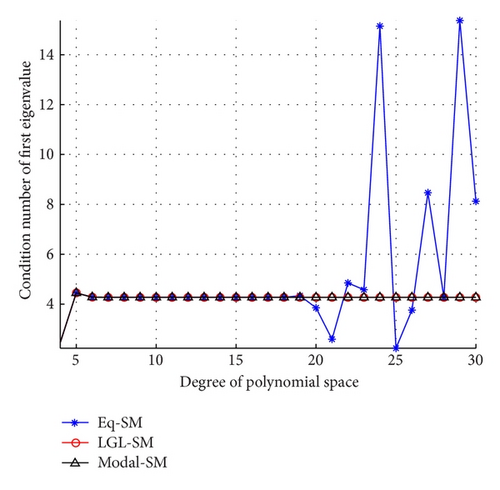
5.1.2. LGL-SM and Modal-SM versus hp-SEM
Tables 1 and 2 indicate that increasing the polynomial degree N or decreasing the mesh fineness h can decrease the errors of the first eigenvalue. But it is expensive to increase polynomial degree and decrease mesh fineness h at the same time. For h = 1/4 and h = 1/16, we obtain from Table 2 the first eigenvalue errors 2.8E − 14 and 1.3E − 13 and the corresponding degree of freedom 1225 and 6241 for hp-SEM, respectively, Whereas from Table 1, to reach this accuracy, LGL-SM and Modal-SM should merely perform the interpolation approximations with polynomial degree bi-14 and bi-13 or so, and the corresponding degrees of freedom are merely 169 and 144, respectively. Therefore, we conclude that LGL-SM and Modal-SM are highly accurate and efficient for this kind of nonsymmetric eigenvalue problems.
| N | h = 1/2 | h = 1/4 | h = 1/8 | h = 1/16 | ||||
|---|---|---|---|---|---|---|---|---|
| Error | DOF | Error | DOF | Error | DOF | Error | DOF | |
| 2 | 5.18E + 00 | 9 | 2.54E − 01 | 49 | 1.50E − 02 | 225 | 9.00E − 04 | 961 |
| 3 | 7.00E − 03 | 25 | 6.10E − 04 | 121 | 1.20E − 05 | 529 | 1.90E − 07 | 2209 |
| 4 | 8.40E − 03 | 49 | 2.60E − 05 | 225 | 9.70E − 08 | 961 | 3.70E − 10 | 3969 |
| 5 | 1.64E − 04 | 81 | 1.60E − 07 | 361 | 1.50E − 10 | 1521 | 1.30E − 13 | 6241 |
| 6 | 4.10E − 07 | 121 | 2.30E − 11 | 529 | 9.90E − 13 | 2209 | 3.60E − 12 | 9025 |
| 7 | 3.10E − 08 | 169 | 1.70E − 12 | 729 | 3.10E − 13 | 3025 | 1.60E − 12 | 12321 |
| 8 | 1.90E − 10 | 225 | 1.90E − 13 | 961 | 2.10E − 12 | 3969 | 4.80E − 12 | 16129 |
| 9 | 5.50E − 13 | 289 | 2.80E − 14 | 1225 | 6.00E − 13 | 5041 | 1.10E − 12 | 20449 |
| 10 | 3.80E − 13 | 361 | 1.10E − 12 | 1521 | 4.40E − 12 | 6241 | 1.50E − 11 | 25281 |
In Figure 2 from [9], when the degree of freedom is up to 1000, the error of linear FEM is about 1E-2; the function value recovery techniques in [9] obviously improves the accuracy up to 1E-5. Comparing Tables 1 and 2 in this paper with Figure 2 in [9], we can also find the advantages of LGL-SM, Modal-SM, and hp-SEM over the function value recovery techniques for FEM given by [9] from accuracy and degree of freedom.
5.1.3. hp-SEM versus hp-FEM
From Table 4, we find that the condition number of the first eigenvalue for hp-version methods (hp-SEM and hp-FEM) stays at 4.27. It is indicated from Tables 2 and 3 that, when N is greater than 7, compared with hp-SEM, the errors of hp-FEM tend to become large, whereas the errors of hp-SEM still keep stable or even stay a decreasing tendency; however, this phenomenon is not apparent for h = 1/2.
| N | h = 1/2 | h = 1/4 | h = 1/8 | h = 1/16 |
|---|---|---|---|---|
| 3 | 7.00E − 03 | 6.10E − 04 | 1.20E − 05 | 1.90E − 07 |
| 4 | 8.40E − 03 | 2.60E − 05 | 9.70E − 08 | 3.70E − 10 |
| 5 | 1.60E − 04 | 1.60E − 07 | 1.50E − 10 | 1.30E − 12 |
| 6 | 4.10E − 07 | 2.40E − 11 | 3.60E − 13 | 8.60E − 12 |
| 7 | 3.10E − 08 | 6.10E − 12 | 1.30E − 11 | 3.00E − 11 |
| 8 | 1.80E − 10 | 3.10E − 11 | 2.30E − 10 | 2.10E − 10 |
| 9 | 7.50E − 11 | 3.40E − 11 | 6.80E − 10 | 7.40E − 10 |
| 10 | 2.50E − 11 | 9.90E − 10 | 8.70E − 09 | 6.60E − 09 |
| 11 | 2.00E − 09 | 9.60E − 09 | 8.90E − 09 | 5.40E − 07 |
| N | h = 1/2 | h = 1/4 | h = 1/8 | h = 1/16 |
|---|---|---|---|---|
| 3 | 4.284381324 | 4.270132842 | 4.269625046 | 4.269615821 |
| 4 | 4.267343095 | 4.269607452 | 4.269615638 | 4.26961567 |
| 5 | 4.269636446 | 4.269615725 | 4.26961567 | 4.26961567 |
| 6 | 4.269619135 | 4.26961567 | 4.26961567 | 4.26961567 |
| 7 | 4.269615617 | 4.26961567 | 4.26961567 | 4.26961567 |
| 8 | 4.26961567 | 4.26961567 | 4.26961567 | 4.26961567 |
| 9 | 4.26961567 | 4.26961567 | 4.26961567 | 4.26961567 |
Remark 21. Condition numbers of 1st eigenvalue for hp-FEM (not listed in Table 4) are almost the same to those for hp-SEM.
5.1.4. Validity of the Error Indicator
From Theorem 19, we know that ψα is a reliable error indicator for λN,h. We choose ψ0 (setting α = 0 in (110)) as a posteriorii error indicator.
In Figures 2 and 3, we denote the true error and est. error with |λN,h − λ| and ψ0, respectively.
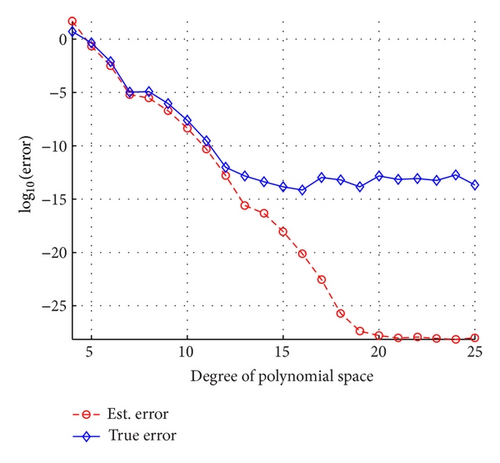
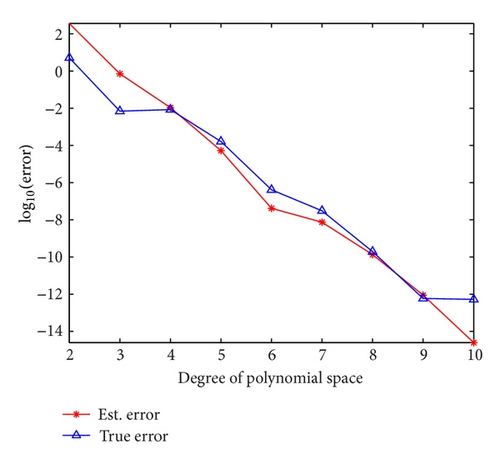
As is depicted in Figure 2, when the polynomial degree N ≤ 12, the error indicator ψ0 can properly estimate the true errors of LGL-SM for the first eigenvalue, however, also slightly underestimate the true errors. It is easy to see that ψ0 shows almost the same algebraic decay as the true error with the polynomial degree N (≤12) increasing. Nevertheless, the error indicator ψ0 cannot approximate the true errors if N is large enough, which is caused by round-off errors derived from the bad condition number of eigenvalue. In Figure 3, we give the comparison between the error indicator ψ0 and the true errors for hp-SEM.
5.2. Example 2
A reference value for the first eigenvalue (simple eigenvalue) of (111) is 34.6397 given by [5]. And the corresponding eigenfunctions have the singularity at the origin. Next, we shall compare the relevant numerical results between P-SEM and the other methods adopted in this paper. Note that here and hereafter P-version methods are for the fixed mesh fineness h = 1. Table 5 lists part data of the approximate eigenvalues computed by P-SEM and the corresponding error indicator ψ0 for reference.
| N | λN,h | ψ0 |
|---|---|---|
| 3 | 28.56900 | 2.72E + 01 |
| 4 | 31.99175 | 3.49E + 00 |
| 5 | 34.82082 | 2.25E − 01 |
| 6 | 34.65087 | 1.31E − 02 |
| 7 | 34.65057 | 3.32E − 03 |
| 8 | 34.64765 | 1.92E − 03 |
| 9 | 34.64567 | 1.22E − 03 |
| 10 | 34.64432 | 8.11E − 04 |
| 11 | 34.64335 | 5.62E − 04 |
| 12 | 34.64265 | 4.02E − 04 |
| 13 | 34.64212 | 2.95E − 04 |
| 14 | 34.64171 | 2.22E − 04 |
| 15 | 34.64139 | 1.71E − 04 |
| 16 | 34.64114 | 1.33E − 04 |
| 17 | 34.64094 | 1.06E − 04 |
| 18 | 34.64078 | 8.49E − 05 |
5.2.1. Stability of P-Version Methods
Figure 4 indicates that the eigenvalues computed by P-FEM will not seriously deviate from the results computed by P-SEM until the interpolation polynomial degree N is up to 19. This phenomenon coincides with the abnormity of condition number of first eigenvalue for P-FEM (see Figure 5). The reason is that the singularities of the eigenfunctions limit the accuracy of both kinds of methods; this is slightly different from the case of the eigenvalue problem with the sufficiently smooth eigenfunctions.
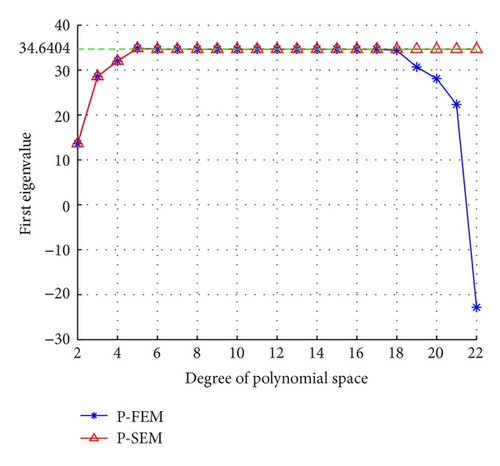
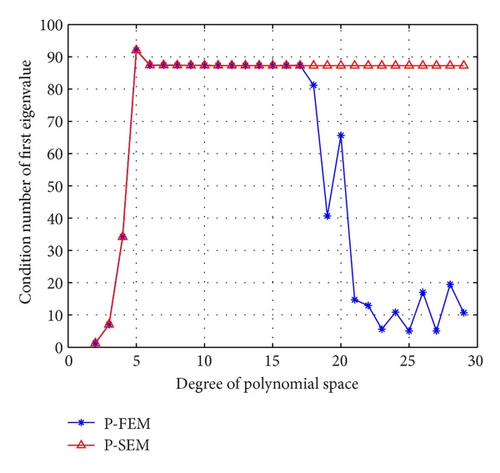
5.2.2. P-SEM versus Other Methods
By calculations, we find that, in the case of the linear FEM, for fixed mesh fineness h = 1/256, the approximate eigenvalue is 34.6403 with degree of freedom up to 195585. But P-SEM with the polynomial degree bi-22 can reach this accuracy, and the corresponding degree of freedom is merely 1365. Compared with the linear FEM, hp-SEM can obtain a higher accuracy with less degrees of freedom as follows: for fixed h = 1/16 and N = 10, the approximate eigenvalue is 34.63984 with degree of freedom 76161 but P-SEM with polynomial degree bi-44 can reach this accuracy. Therefore, P-SEM is more efficient for the eigenvalue problems with the singular solutions than the other methods.
Acknowledgments
This work was supported by the National Natural Science Foundation of China (Grant no. 11161012) and the Educational Administration and Innovation Foundation of Graduate Students of Guizhou Normal University (no. 2012(11)).




